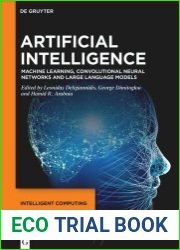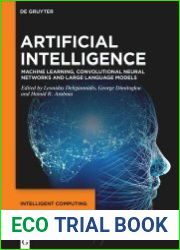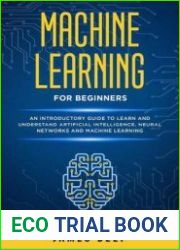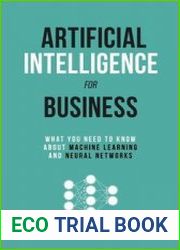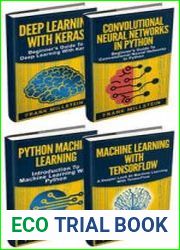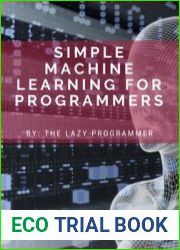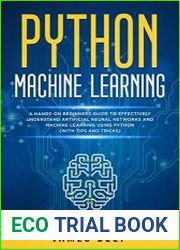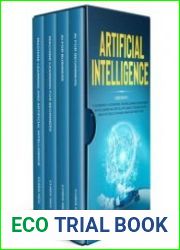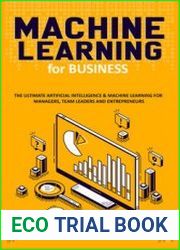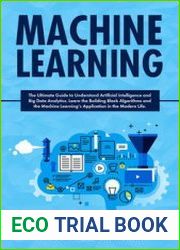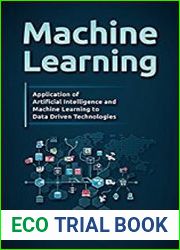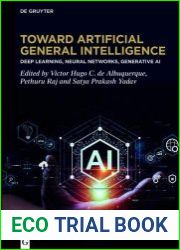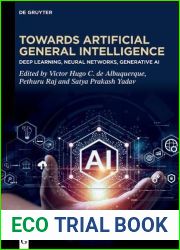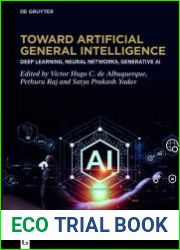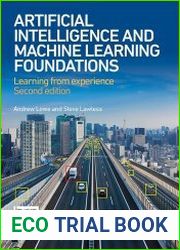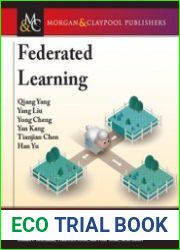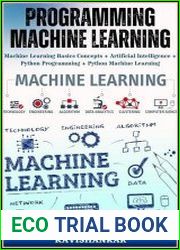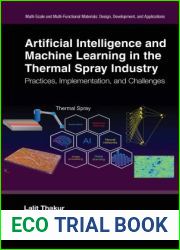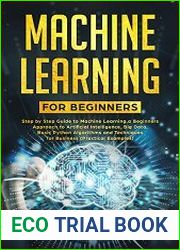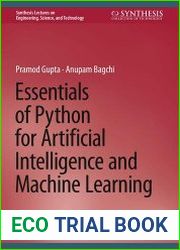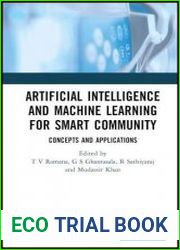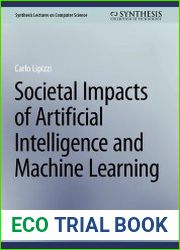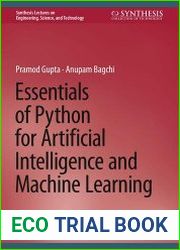
BOOKS - Artificial Intelligence Machine Learning, Convolutional Neural Networks and L...

Artificial Intelligence Machine Learning, Convolutional Neural Networks and Large Language Models
Author: Leonidas Deligiannidis, George Dimitoglou, Hamid R. Arabnia
Year: 2024
Pages: 442
Format: PDF | EPUB
File size: 27.5 MB
Language: ENG

Year: 2024
Pages: 442
Format: PDF | EPUB
File size: 27.5 MB
Language: ENG

The book "Artificial Intelligence Machine Learning Convolutional Neural Networks and Large Language Models" explores the intersection of artificial intelligence, machine learning, convolutional neural networks, and large language models, providing readers with a comprehensive understanding of these technologies and their applications. The book begins by discussing the history and evolution of artificial intelligence, from its early beginnings to the current state-of-the-art techniques used today. It then delves into the principles of machine learning, including supervised and unsupervised learning, and the role of deep learning in modern AI systems. The next section focuses on convolutional neural networks (CNNs), which are a type of neural network architecture that has revolutionized image recognition and processing tasks. The authors provide an in-depth explanation of how CNNs work, including the use of convolutional layers, pooling layers, and activation functions. They also discuss the challenges associated with training CNNs and the various techniques used to overcome these challenges. The book then moves on to large language models, which have become increasingly popular in recent years due to their ability to process and generate human-like text. The authors explore the different types of language models, such as recurrent neural networks (RNNs) and transformer models, and discuss their applications in natural language processing tasks like language translation and sentiment analysis.
Книга «Свёрточные нейронные сети машинного обучения искусственного интеллекта и большие языковые модели» исследует пересечение искусственного интеллекта, машинного обучения, свёрточных нейронных сетей и больших языковых моделей, предоставляя читателям исчерпывающее понимание этих технологий и их приложений. Книга начинается с обсуждения истории и эволюции искусственного интеллекта, от его ранних истоков до современных современных техник, используемых сегодня. Затем он углубляется в принципы машинного обучения, включая обучение с учителем и без учителя, и роль глубокого обучения в современных системах ИИ. Следующий раздел посвящен сверточным нейронным сетям (CNN), которые представляют собой тип архитектуры нейронных сетей, которая произвела революцию в задачах распознавания и обработки изображений. Авторы дают подробное объяснение того, как работают CNN, включая использование сверточных слоев, пулинговых слоев и функций активации. Они также обсуждают проблемы, связанные с обучением CNN, и различные методы, используемые для преодоления этих проблем. Затем книга переходит к большим языковым моделям, которые становятся все более популярными в последние годы из-за их способности обрабатывать и генерировать текст, похожий на человеческий. Авторы исследуют различные типы языковых моделей, такие как рекуррентные нейронные сети (RNN) и модели-трансформеры, и обсуждают их применение в задачах обработки естественного языка, таких как перевод языка и анализ настроений.
livre « s réseaux neuronaux de l'apprentissage automatique de l'intelligence artificielle et les grands modèles linguistiques » explore l'intersection de l'intelligence artificielle, de l'apprentissage automatique, des réseaux neuronaux de swing et des grands modèles linguistiques, offrant aux lecteurs une compréhension exhaustive de ces technologies et de leurs applications. livre commence par discuter de l'histoire et de l'évolution de l'intelligence artificielle, depuis ses origines initiales jusqu'aux techniques modernes utilisées aujourd'hui. Il approfondit ensuite les principes de l'apprentissage automatique, y compris l'apprentissage avec et sans professeur, et le rôle de l'apprentissage profond dans les systèmes modernes d'IA. La section suivante est consacrée aux réseaux neuronaux convolutifs (CNN), qui sont un type d'architecture de réseaux neuronaux qui a révolutionné les tâches de reconnaissance et de traitement d'images. s auteurs fournissent une explication détaillée de la façon dont CNN fonctionne, y compris l'utilisation de couches convolutives, de couches de puling et de fonctions d'activation. Ils discutent également des défis liés à l'apprentissage de CNN et des différentes méthodes utilisées pour surmonter ces défis. livre passe ensuite à de grands modèles linguistiques qui sont devenus de plus en plus populaires ces dernières années en raison de leur capacité à traiter et à générer un texte similaire à celui de l'homme. s auteurs explorent différents types de modèles linguistiques, tels que les réseaux neuronaux récurrents (RNN) et les modèles transformateurs, et discutent de leur application aux tâches de traitement du langage naturel telles que la traduction linguistique et l'analyse des humeurs.
libro «Redes neuronales convulsivas de aprendizaje automático de inteligencia artificial y grandes modelos de lenguaje» explora la intersección de inteligencia artificial, aprendizaje automático, redes neuronales convulsivas y grandes modelos de lenguaje, proporcionando a los lectores una comprensión exhaustiva de estas tecnologías y sus aplicaciones. libro comienza con una discusión sobre la historia y la evolución de la inteligencia artificial, desde sus primeros orígenes hasta las modernas técnicas modernas utilizadas en la actualidad. Luego se profundiza en los principios del aprendizaje automático, incluyendo el aprendizaje con y sin maestro, y el papel del aprendizaje profundo en los sistemas de IA modernos. La siguiente sección se centra en las redes neuronales perforadas (CNN), que son un tipo de arquitectura de redes neuronales que ha revolucionado las tareas de reconocimiento y procesamiento de imágenes. autores proporcionan una explicación detallada de cómo funciona CNN, incluyendo el uso de capas de taladrado, capas de pulido y funciones de activación. También discuten los desafíos relacionados con el aprendizaje de CNN y las diferentes técnicas utilizadas para superar estos problemas. libro pasa entonces a grandes modelos lingüísticos cada vez más populares en los últimos por su capacidad para procesar y generar un texto similar al humano. autores investigan diferentes tipos de modelos de lenguaje, como las redes neuronales recurrativas (RNN) y los modelos transformadores, y discuten su aplicación en tareas de procesamiento del lenguaje natural, como la traducción del lenguaje y el análisis del sentimiento.
Il libro «Reti neurali di apprendimento automatico dell'intelligenza artificiale e modelli linguistici di grandi dimensioni» esamina l'intersezione tra intelligenza artificiale, apprendimento automatico, reti neurali composte e modelli linguistici di grandi dimensioni, fornendo ai lettori una comprensione completa di queste tecnologie e delle loro applicazioni. Il libro inizia con un dibattito sulla storia e l'evoluzione dell'intelligenza artificiale, dalle sue origini iniziali alle moderne tecniche utilizzate oggi. Poi approfondisce i principi dell'apprendimento automatico, compreso l'apprendimento con il maestro e senza il maestro, e il ruolo dell'apprendimento profondo nei sistemi di IA moderni. La sezione seguente è dedicata alle reti neurali compresse (CNN), che rappresentano il tipo di architettura delle reti neurali che ha rivoluzionato le sfide di riconoscimento e elaborazione delle immagini. Gli autori forniscono una spiegazione dettagliata di come la CNN funziona, tra cui l'uso di strati compressi, livelli di pulming e funzioni di attivazione. Discutono anche dei problemi legati all'apprendimento della CNN e dei vari metodi utilizzati per superare questi problemi. Poi il libro passa ai più grandi modelli linguistici, che sono diventati sempre più popolari negli ultimi anni a causa della loro capacità di elaborare e generare un testo simile a quello umano. Gli autori esaminano diversi tipi di modelli linguistici, come le reti neurali ricorrenti (RNN) e i modelli trasformatori, e ne discutono l'utilizzo nelle attività di elaborazione del linguaggio naturale, come la traduzione della lingua e l'analisi degli umori.
Das Buch „Twisted Neural Networks of Machine arning of Artificial Intelligence and Large Language Models“ untersucht die Schnittstelle von künstlicher Intelligenz, maschinellem rnen, Twisted Neural Networks und großen Sprachmodellen und bietet den sern einen umfassenden Einblick in diese Technologien und ihre Anwendungen. Das Buch beginnt mit einer Diskussion über die Geschichte und Entwicklung der künstlichen Intelligenz, von ihren frühen Ursprüngen bis zu den modernen modernen Techniken, die heute verwendet werden. Anschließend werden die Prinzipien des maschinellen rnens, einschließlich des rnens mit und ohne hrer, und die Rolle des Deep arning in modernen KI-Systemen vertieft. Der nächste Abschnitt befasst sich mit Convolutional Neural Networks (CNNs), einer Art neuronaler Netzwerkarchitektur, die die Aufgaben der Bilderkennung und -verarbeitung revolutioniert hat. Die Autoren geben eine detaillierte Erklärung, wie CNNs funktionieren, einschließlich der Verwendung von Faltungsschichten, Pooling-Schichten und Aktivierungsfunktionen. e diskutieren auch die Herausforderungen, die mit dem Training von CNN verbunden sind, und die verschiedenen Techniken, die zur Bewältigung dieser Herausforderungen eingesetzt werden. Das Buch geht dann zu den großen Sprachmodellen über, die in den letzten Jahren aufgrund ihrer Fähigkeit, Text ähnlich wie den Menschen zu verarbeiten und zu generieren, immer beliebter geworden sind. Die Autoren untersuchen verschiedene Arten von Sprachmodellen wie rekurrente neuronale Netze (RNNs) und Transformatormodelle und diskutieren deren Anwendung in natürlichen Sprachverarbeitungsaufgaben wie Sprachübersetzung und Stimmungsanalyse.
הספר Convolutional Neural Networks of Artificial Intelligence Machine arning and Larg Language Models חוקר את הצומת של בינה מלאכותית, למידת מכונה, רשתות עצביות קונבולוציוניות ומודלים של שפות גדולות, ומספק לקוראים הבנה מקיפה של טכנולוגיות ויישומים. הספר מתחיל בדיון בהיסטוריה ובאבולוציה של הבינה המלאכותית, החל ממקורותיה המוקדמים ועד לטכניקות מודרניות המשמשות כיום. לאחר מכן הוא מתעמק בעקרונות של למידת מכונה, כולל למידה מפוקחת ובלתי מפוקחת, ותפקיד הלמידה העמוקה במערכות הבינה המלאכותית המודרניות. החלק הבא מתמקד ברשתות עצביות קונבולוציוניות (CALL), שהן סוג של ארכיטקטורת רשת עצבית שחוללה מהפכה בזיהוי תמונה ובמשימות עיבוד. המחברים מספקים הסבר מפורט על אופן העבודה של CALL, כולל שימוש בשכבות קונבולוציוניות, שכבות איסוף ופונקציות הפעלה. הם גם דנים באתגרים הקשורים באימוני CNN ובשיטות השונות שבהן משתמשים כדי להתגבר על אתגרים אלה. הספר עובר למודלים גדולים בשפה, שהפכו פופולריים בשנים האחרונות בשל יכולתם לעבד וליצור טקסט דמוי אדם. המחברים חוקרים סוגים שונים של מודלים של שפה, כגון רשתות עצביות חוזרות ונשנות (RNNs) ומודלים של שנאים, ודנים ביישום שלהם במשימות עיבוד שפות טבעיות כמו תרגום שפה וניתוח מצב רוח.''
"Yapay Zeka Makine Öğrenimi ve Büyük Dil Modellerinin Evrişimli nir Ağları" kitabı, yapay zeka, makine öğrenimi, evrişimli sinir ağları ve büyük dil modellerinin kesişimini araştırıyor ve okuyuculara bu teknolojiler ve uygulamaları hakkında kapsamlı bir anlayış sunuyor. Kitap, ilk kökenlerinden bugün kullanılan modern modern tekniklere kadar yapay zekanın tarihini ve evrimini tartışarak başlıyor. Daha sonra denetlenen ve denetlenmeyen öğrenme ve modern AI sistemlerinde derin öğrenmenin rolü de dahil olmak üzere makine öğreniminin ilkelerini araştırıyor. Bir sonraki bölüm, görüntü tanıma ve işleme görevlerinde devrim yaratan bir tür sinir ağı mimarisi olan evrişimli sinir ağlarına (CNN'ler) odaklanmaktadır. Yazarlar, evrişimli katmanların, havuzlama katmanlarının ve aktivasyon fonksiyonlarının kullanımı da dahil olmak üzere CNN'lerin nasıl çalıştığına dair ayrıntılı bir açıklama sunmaktadır. Ayrıca CNN eğitimi ile ilgili zorlukları ve bu zorlukların üstesinden gelmek için kullanılan çeşitli yöntemleri tartışıyorlar. Kitap daha sonra, insan benzeri metinleri işleme ve üretme yetenekleri nedeniyle son yıllarda giderek daha popüler hale gelen büyük dil modellerine geçiyor. Yazarlar, tekrarlayan sinir ağları (RNN'ler) ve transformatör modelleri gibi farklı dil modellerini araştırıyor ve uygulamalarını dil çevirisi ve ruh hali analizi gibi doğal dil işleme görevlerinde tartışıyorlar.
يستكشف كتاب «الشبكات العصبية التلافيفية للتعلم الآلي للذكاء الاصطناعي ونماذج اللغة الكبيرة» تقاطع الذكاء الاصطناعي والتعلم الآلي والشبكات العصبية التلافيفية ونماذج اللغات الكبيرة، مما يوفر للقراء فهمًا شاملاً لهذه التقنيات وتطبيقاتها. يبدأ الكتاب بمناقشة تاريخ وتطور الذكاء الاصطناعي، من أصوله المبكرة إلى التقنيات الحديثة الحديثة المستخدمة اليوم. ثم يتعمق في مبادئ التعلم الآلي، بما في ذلك التعلم الخاضع للإشراف وغير الخاضع للإشراف، ودور التعلم العميق في أنظمة الذكاء الاصطناعي الحديثة. يركز القسم التالي على الشبكات العصبية التلافيفية (CNNs)، وهي نوع من بنية الشبكة العصبية التي أحدثت ثورة في مهام التعرف على الصور ومعالجتها. يقدم المؤلفون شرحًا مفصلاً لكيفية عمل CNNs، بما في ذلك استخدام طبقات التلافيف وطبقات التجميع ووظائف التنشيط. كما يناقشون التحديات المرتبطة بتدريب CNN والطرق المختلفة المستخدمة للتغلب على هذه التحديات. ينتقل الكتاب بعد ذلك إلى نماذج لغوية كبيرة، والتي أصبحت شائعة بشكل متزايد في السنوات الأخيرة بسبب قدرتها على معالجة وتوليد نص يشبه الإنسان. يستكشف المؤلفون أنواعًا مختلفة من نماذج اللغة، مثل الشبكات العصبية المتكررة (RNNs) ونماذج المحولات، ويناقشون تطبيقها في مهام معالجة اللغة الطبيعية مثل ترجمة اللغة وتحليل الحالة المزاجية.
「人工智能機器學習的卷積神經網絡和大語言模型」一書探討了人工智能,機器學習,卷積神經網絡和大語言模型的交集,為讀者提供了對這些技術及其應用的詳盡見解。這本書首先討論了人工智能的歷史和演變,從其早期的起源到當今使用的現代技術。然後,他深入研究機器學習的原理,包括與老師和非老師一起學習,以及深度學習在現代AI系統中的作用。下一節討論卷積神經網絡(CNN),卷積神經網絡是一種神經網絡架構,徹底改變了圖像識別和處理任務。作者詳細解釋了CNN的運作方式,包括使用卷積層,子彈層和激活功能。他們還討論了CNN培訓帶來的挑戰以及克服這些挑戰的各種方法。然後,該書轉向大型語言模型,由於其處理和生成類似於人類的文本的能力,近來變得越來越流行。作者研究了不同類型的語言模型,例如遞歸神經網絡(RNN)和變形金剛模型,並討論了它們在自然語言處理任務(例如語言翻譯和情緒分析)中的應用。







